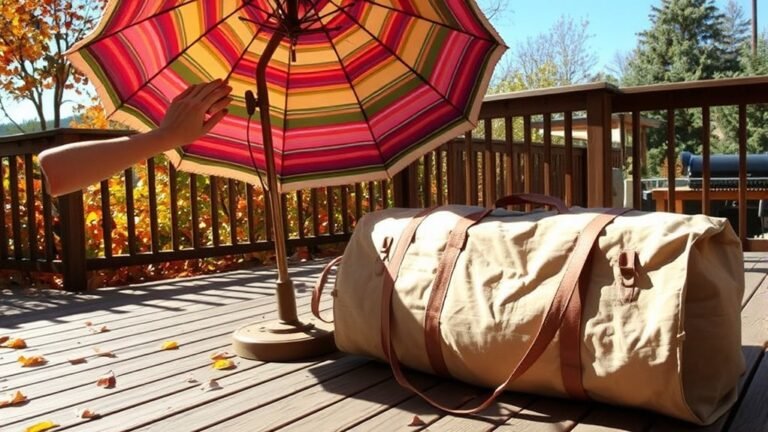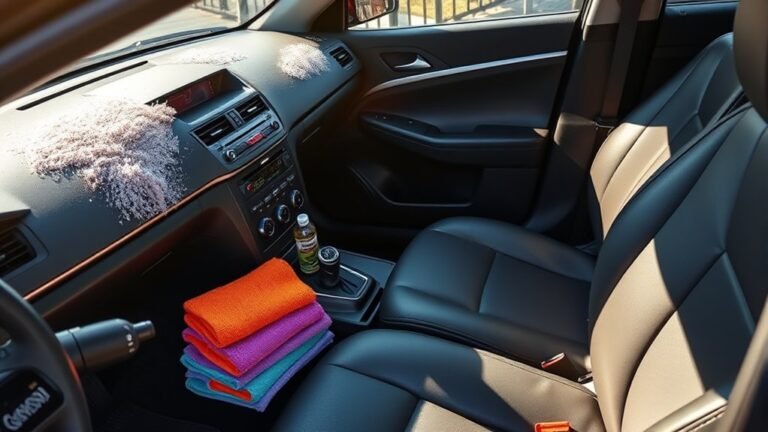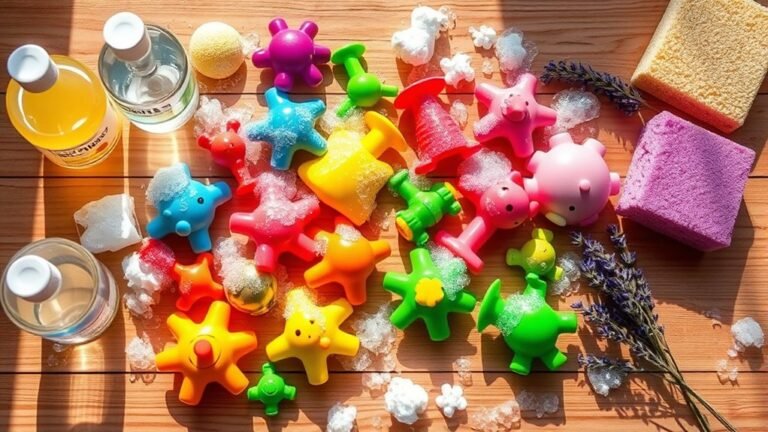Cleaning for Unique Surfaces and Materials
When cleaning unique surfaces like delicate wood, antique textiles, or polished metals, you’ll want to use gentle methods to avoid damage. Soft cloths, mild soaps, and specialized cleaners keep materials intact while preserving their appearance. Avoid harsh chemicals and abrasive tools, especially on marble, leather, and porcelain. Regular maintenance prevents buildup and wear. If you keep these tips in mind, you’ll easily preserve your prized items and discover expert advice to maintain various materials properly.
Cleaning Techniques for Delicate Wood Surfaces

When cleaning delicate wood surfaces, you’ll want to use gentle methods to avoid damage. Start by dusting lightly with a soft cloth to remove loose particles without scratching. Avoid harsh chemicals or abrasive tools that can strip the finish or mar the grain. After dusting, apply a quality wood polish sparingly—this not only enhances the wood’s natural beauty but also offers surface protection against moisture and wear. You can use a microfiber cloth to spread the polish evenly, ensuring it penetrates without leaving residue. Remember, maintaining freedom in your space means caring for your belongings thoughtfully, so these simple steps keep your wood looking fresh and protected without restricting your lifestyle or requiring complicated routines. This approach lets your furniture breathe and shine naturally.
Caring for Antique and Vintage Textiles
Just as delicate wood surfaces need gentle care, antique and vintage textiles require special attention to preserve their beauty and integrity. When you’re handling these fabrics, avoid harsh chemicals or vigorous washing that might weaken fibers. Instead, opt for gentle cleaning methods like hand washing with mild soap and cold water, then air drying flat to prevent distortion. For tears or worn spots, fabric repair is essential—patching or darning helps maintain the textile’s strength without compromising its look. Remember, antique preservation isn’t about making items look brand new but about honoring their history while keeping them usable. By treating your vintage textiles thoughtfully, you’re free to enjoy their unique charm for years to come without risking damage or loss of character.
Maintaining the Shine on Copper and Brass
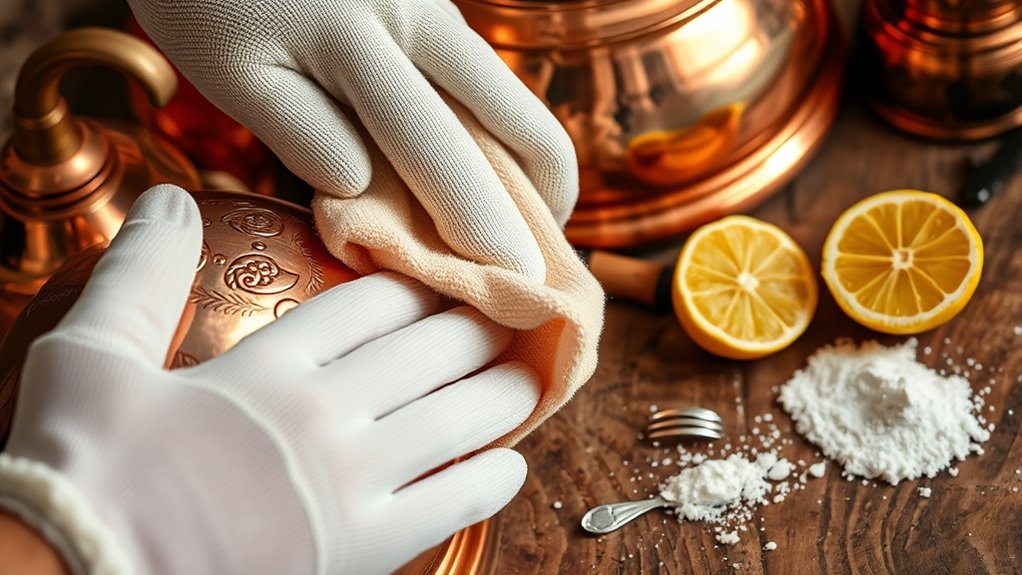
Although copper and brass develop a natural patina over time, you’ll often want to restore their original shine to highlight their warm, rich tones. Achieving this requires mastering polishing techniques and effective oxidation removal without harming the metal’s surface. You can use gentle abrasives or natural solutions like lemon and baking soda to bring back brilliance.
| Polishing Techniques | Oxidation Removal |
|---|---|
| Use soft cloths | Apply lemon juice mix |
| Avoid harsh chemicals | Gently scrub with paste |
| Buff in circular motion | Rinse and dry thoroughly |
| Maintain regularly | Prevent future buildup |
Best Practices for Cleaning Marble and Stone
Cleaning marble and stone requires a careful approach since these materials can be sensitive to acidic or abrasive cleaners. You’ll want to avoid harsh chemicals and opt for a gentle, pH-neutral cleaner instead. For marble maintenance, regularly wipe surfaces with a soft cloth and warm water to keep them spotless without causing damage. Stone sealing is essential to protect porous surfaces from stains and moisture, so be sure to reseal your stone periodically—usually every 6 to 12 months, depending on use. This simple step lets you enjoy your stone’s natural beauty without worry. By following these best practices, you’ll preserve the elegance of your marble and stone, giving you the freedom to live beautifully without stressing over damage or dullness.
How to Clean and Preserve Leather Goods
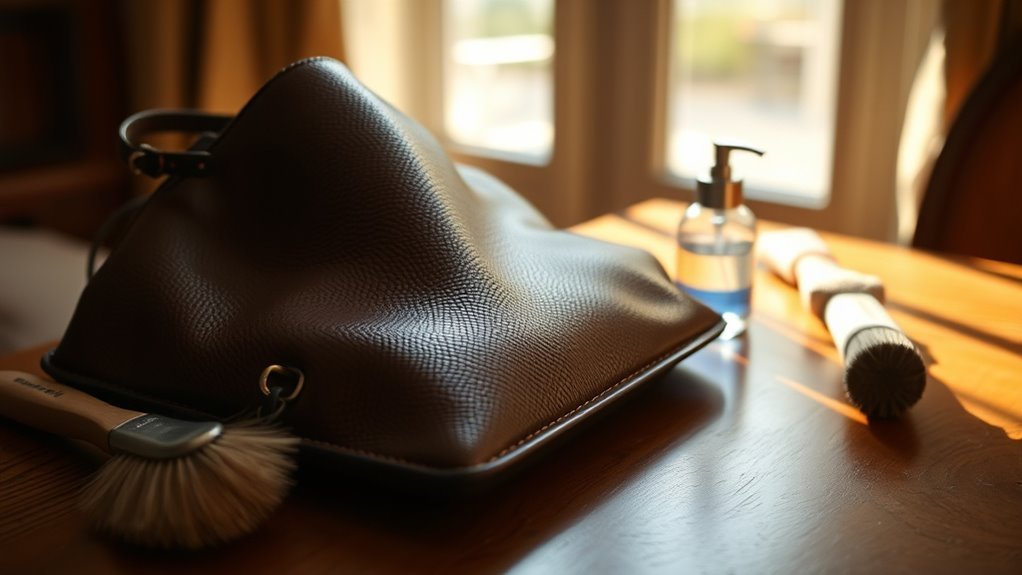
When cleaning leather goods, you’ll want to pick a cleaner that’s gentle and designed specifically for leather to avoid damage. Conditioning and moisturizing are key to keeping the material soft and preventing cracks over time. Also, proper storage can make a big difference in preserving your leather’s quality and appearance.
Choosing the Right Cleaner
Since leather is a delicate material, you need to pick a cleaner that won’t damage its texture or color. When selecting detergents, opt for mild, pH-balanced options specifically designed for leather. Avoid harsh chemicals, bleach, or ammonia that can strip natural oils and cause cracking. Eco friendly cleaners are your best bet—they clean effectively while respecting the environment and your leather’s integrity. Look for products labeled biodegradable and free from synthetic fragrances or dyes. Before applying any cleaner, test it on a small, hidden patch to verify it won’t discolor or weaken the leather. By choosing the right cleaner, you maintain your leather goods’ natural beauty and freedom to enjoy them without worry or damage.
Conditioning and Moisturizing Tips
Proper conditioning and moisturizing are key to keeping your leather goods soft, supple, and resistant to cracks. Using moisturizing oils and conditioning balms regularly restores natural oils lost over time, preventing dryness and brittleness. Apply them sparingly and evenly, allowing the leather to fully absorb for lasting protection. Here’s a quick guide:
| Product Type | Purpose | Application Tips |
|---|---|---|
| Conditioning Balm | Deep nourishment | Use a soft cloth, rub gently |
| Moisturizing Oil | Restores flexibility | Apply thin layers, let dry |
| Leather Cream | Surface shine & protection | Buff after application |
| Beeswax-based Balm | Water resistance | Use for outdoor/leisure items |
| pH-Balanced Lotion | Daily maintenance | Use sparingly, avoid overuse |
Stay consistent, and your leather will keep its freedom to move and age beautifully.
Storing Leather Properly
How do you guarantee your leather goods stay in top shape long after cleaning and conditioning? Proper leather storage is key. You want to keep your items in a cool, dry place away from direct sunlight to prevent fading and cracking. Humidity control is essential—too much moisture invites mold, while too little causes dryness and brittleness. Use breathable fabric bags or cotton covers instead of plastic, which traps moisture. Stuff bags or shoes with acid-free tissue paper to help maintain their shape and absorb excess humidity. Remember, freedom with your leather means letting it breathe and rest properly between uses. By managing your environment carefully, you make sure your leather stays supple, durable, and ready for wherever your journey takes you next.
Tips for Washing Silk and Other Fine Fabrics
When caring for silk and other fine fabrics, you’ll want to handle them gently to maintain their delicate texture and vibrant colors. Start with cold water and a mild detergent designed for silk washing to prevent damage. Avoid harsh chemicals and never wring or twist the fabric; instead, press water out softly. Hand washing is usually best, giving you control and reducing stress on the fibers. Lay your garment flat on a clean towel to dry, keeping it away from direct sunlight to avoid fading. For fabric care, always check the garment’s label first, and if in doubt, opt for professional cleaning. Treat your fine fabrics with respect, and you’ll enjoy their freedom of movement and elegance for years to come.
Handling and Cleaning Porcelain and Ceramics
When cleaning porcelain, you’ll want to use gentle, non-abrasive cleaners to avoid scratches. For ceramics, regular maintenance with a soft cloth can keep surfaces looking fresh without damage. Let’s explore the best ways to handle and care for these delicate materials.
Porcelain Cleaning Tips
Porcelain and ceramics require gentle care to keep their delicate surfaces looking pristine. When tackling porcelain stain removal, start with a soft cloth and mild detergent—harsh chemicals can damage the glaze. For stubborn stains, a paste of baking soda and water works wonders without scratching. Avoid abrasive tools that might dull the finish. Once clean, you can enhance your porcelain’s shine using porcelain polishing techniques like a gentle buff with a microfiber cloth and a non-abrasive polish specifically made for ceramics. Remember, regular light cleaning prevents buildup, so you won’t need aggressive stain removal later. By treating your porcelain with care and using the right products, you maintain its beauty and enjoy the freedom of worry-free cleaning every time.
Ceramic Surface Maintenance
Ceramic surfaces demand careful handling to preserve their smooth finish and prevent chips or cracks. You’ll want to focus on glaze maintenance to keep your ceramics looking fresh and vibrant. When it comes to stain removal, act quickly—ceramics can absorb stains if left too long. Here’s how you can maintain your ceramic pieces without hassle:
- Use a soft cloth or sponge with mild detergent to avoid scratching the glaze.
- Avoid abrasive cleaners or harsh chemicals that may dull or damage the surface.
- For stubborn stains, try a paste of baking soda and water, gently rubbed and rinsed.
- Dry thoroughly after cleaning to prevent water spots and maintain that shiny finish.
With these tips, your ceramics will stay beautiful and free, just like you want.
Safe Methods for Cleaning Electronic Screens and Devices
Although electronic screens are delicate, you don’t have to worry about damaging them if you clean them properly. To maintain screen protection, always use a soft, lint-free microfiber cloth. Avoid harsh chemicals or paper towels that can scratch or degrade your device. For device sanitization, lightly dampen the cloth with a mix of 70% isopropyl alcohol and water—never spray liquids directly onto the screen. Gently wipe in circular motions to remove fingerprints and germs without risking damage. Remember to power off your device before cleaning to prevent accidental inputs. By following these safe methods, you’ll keep your screens crystal clear and your devices hygienic without compromising their integrity, giving you the freedom to enjoy your tech worry-free.
Frequently Asked Questions
How Do I Remove Mold From Rare Plant Specimens?
If you want to remove mold from rare plant specimens, you’ll need a gentle mold treatment that won’t harm them. Start by isolating the plant to prevent mold spread. Use a soft brush or cloth dipped in a mild fungicide or diluted neem oil to carefully clean affected areas. This approach supports plant preservation while giving you freedom to nurture your unique collection without harsh chemicals or damage.
Can I Clean Gemstone Jewelry With Household Products?
Imagine your gemstone jewelry sparkling like a hidden treasure chest under the sun. You can use gentle household products like mild soap and warm water for gemstone care, but avoid harsh chemicals that could dull their shine. For jewelry maintenance, a soft brush helps reach tiny crevices. Always rinse and dry thoroughly to keep your gems glowing freely. Treat them with care, and your jewelry will shine bright for years to come.
What’S the Best Way to Deodorize Vintage Books?
If you want to deodorize vintage books, start by airing them out in a dry, well-ventilated space—this simple step helps reduce odors naturally. You can also place them in a sealed container with baking soda or activated charcoal nearby (not directly touching) to absorb smells. Remember, gentle book preservation techniques and vintage paper care mean avoiding harsh chemicals or moisture that could damage the pages. This way, your books stay fresh and free to enjoy.
How Do I Clean Delicate Feathers Without Damage?
Handling delicate feathers is like walking on eggshells—you’ve got to be gentle to avoid damage. For proper feather care, use soft brushes or a hairdryer on a cool, low setting to remove dust. Avoid water unless absolutely necessary, and if you must, use mild soap with lukewarm water, then pat dry softly. These cleaning techniques let you preserve their natural beauty while giving your feathers the freedom to shine without harm.
Is It Safe to Use Steam Cleaning on Musical Instruments?
You might think steam cleaning is a quick fix, but when it comes to your musical instruments, steam cleaning safety is essential. High heat and moisture can warp wood, damage finishes, or ruin delicate parts. Instead, stick to gentle wiping and proper instrument maintenance to keep your sound pure and your gear intact. Freedom in playing means caring smartly for your instruments, avoiding shortcuts that could cost you in the long run.
